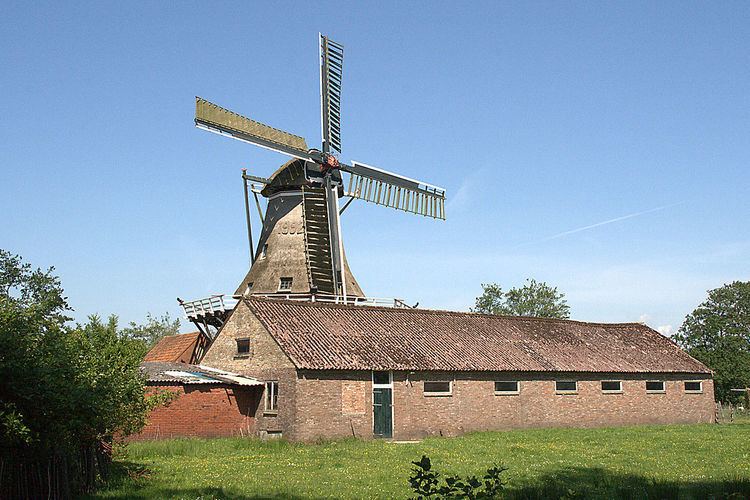Purpose Corn mill Storeys Two storey smock Year built 1864 | ||
 | ||
Mill name KoartwâldFeanstermoune Operator(s) Stichting De Feanster Moune Hours Closed today ThursdayClosedFridayClosedSaturday9AM–12PMSundayClosedMondayClosedTuesdayClosedWednesdayClosed | ||
Molen de notm ne koartw ld surhuisterveen
Koartwâld, or Feanstermoune is a smock mill in Surhuisterveen, Friesland, Netherlands, which was built in 1864 and has been restored to working order. The mill is listed as a Rijksmonument.
Contents
Molen de notm ne koartw ld surhuisterveen
History
The previous mill near this site was a post mill. A mill stood here in 1664 and one was marked on a map dated 1718, described as a rye mill. In 1850, a post mill was built on the opposite side of the road to Koartwâld. It burnt down on 4 August 1864.
Koartwâld was built in 1864 for the Van Schepen family. The mill was sold by K B Kloosterman in 1905. It was bought by H Sietzma, who refurbished the mill. Patent sails were fitted in 1906. These were later fitted with leading edges on the Dekker system. In 1907, a petrol engine was installed to drive the mill when the wind was not blowing. A storm on 24 September 1946 decapitated the mill, damaging the stage, which was then removed.
In 1990, a society was formed with the intention of restoring the mill to working order. The new windshaft came from the Puurveense Molen, Kootwijkerbroek, Gelderland, which had burnt down in 1964. Restoration began in 1991, with the mill officially being opened on National Mills Day, 1995. The mill is listed as a Rijksmonument, № 511200.
Description
Koartwâld is what the Dutch describe as a "Stellingmolen". It is a smock mill on a brick base. The stage is 6.24 metres (20 ft 6 in) above ground level. The smock and cap are thatched. The mill is winded by tailpole and winch. The sails are Patent sails. They have a span of 18.70 metres (61 ft 4 in). The sails are carried on a cast iron windshaft, which was cast by the IJzergieterij De Prins van Oranje, 's Gravenhage, South Holland in 1889. The windshaft also carries the brake wheel, which has 54 cogs. This drives the wallower (29 cogs) at the top of the upright shaft. At the bottom of the upright shaft is the great spur wheel, which has 74 cogs. The great spur wheel drives a pair of Cullen millstones and a pair of Peak millstones via lantern pinion stone nuts which have 22 staves each. Both pairs of millstones are 1.40 metres (4 ft 7 in) diameter. Auxiliary power is a single-cylinder two-stroke 50 horsepower (37 kW) Brons diesel engine dating from 1933. There is also a three-cylinder McLaren diesel engine dating from 1943.
Public access
Koartwâld is open to the public on Saturdays between 09:00 and 12:00, or by appointment.
